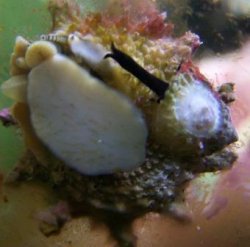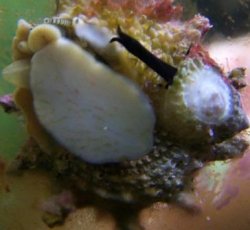Ah, I have those. Mine rode in on some Turbos and the shells of my Dardanus hermits and have been multiplying in my 55gal. I never did get a solid ID on them but I recall that they are related to some other univalves called slipper shells - the things that tend to stack up by pickybacking on each other and can be a pest in oyster farms (not by eating the oysters though; I'm not 100% sure what they do that interfers). They stay put and tend to appear in clusters. Odd thing is that in the literature all of these I've read about are labeled as filter feeders, but these, if they do filter feed by the same mechanisms as slipper shells, certainly also graze as you've seen. When on snails, i have seen no evidence of harm to the host. If you find that this one is hindering the host snail or presenting a problem for growth (that is a VERY odd location for it, I have to admit), you could try to pry it off, although this may hurt it and/or kill it and might not be possible to do safely for the host snail depending on how much of a fight it puts up. These strange beasties hold on pretty tight and I have never tried relocating one, so I don't know whether they latch onto other things willingly or if being dislodged is the end for them even if they survive being pried away from their original location.
Also, obligatory note on strange critters growing on snail shells: just because the critters in this thread do no harm to the host as far as I've seen doesn't mean all things looking vaguely like them on gastropod shells are harmless. There are some similar-looking, somewhat smaller critters that are basically a gastropod-parasitizing version of the little limpet things (whose names are escaping me) that attack starfish. The difference with the safe ones in this thread is that the shell, in addition to being more irregular, appears to grow fully on top of the host from what I've seen of them. It might leave the host shell a bit lumpy but they are clearly on top and not digging in. The nasty ones I've seen in the past eat away at the host shell and end up set down into it, which makes them incredibly hard to remove. They then bore a smaller hole straight through the host shell to attack the soft tissue with their probocis.



